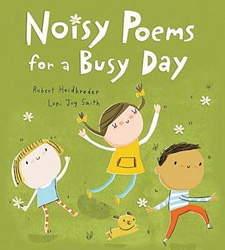Can Write: Meeting Canadian Writers and Illustrators of Children’s Books
What inspires the writers of the books your students read? How does an illustrator decide what to draw? Is it true that most authors and illustrators don’t know each other? This column features a different Canadian children’s book creator in each issue and shows you the story beyond the covers.
For many years I have admired the playful poetry books written by Vancouver author Robert Heidbreder. I knew he was a teacher and asked him about two of passions: writing and teaching.
How did teaching lead to writing for you?
When I first started teaching, I had a wonderfully mixed class—ages, nationalities, abilities—and I noticed how children were drawn to rhyme and rhythm. This was something the prescribed readers did not warmly address. I turned to poems I remembered as a child, searched out new poems and new poets (Dennis Lee’s first books were just appearing!) and then began writing poems for my class to supplement the units of study we were exploring.
After I had written many poems, my wife encouraged me to try to get them published. That is how my first book, Don’t Eat Spiders (Oxford, 1985) came about. It reflects what my K/1/2 classes studied and explored over the first years of my teaching.
Tell us about your writing process. Do you mull things over for a long time? Do you try out poems on kids

I do not have set routines for writing, which means I can be a slow writer. I wait until my mind relaxes and I’m receptive to the free flow of playful ideas—the proverbial muse, I guess.
Dancing dinosaurs, wishing for a unicorn, crocodiles at work! How do you get your ideas now that you are not in a kindergarten full time anymore?
I have always had an active, lively imagination, much to my mother’s horror at times as I grew up. My imaginary friends were many and of all sorts and sizes. Everything in my world could have a voice and often did. Food talked (especially food I didn’t like, which told me not to eat it!); pets of course talked, trees, flowers, cars and my favourite stuffed animal. I even gave my older sister a voice of my own. I carried this love of voices (and writing is about voice) to my classroom and created an unruly band of puppets, each with a unique song.
Teaching young children re-activated my imagination and love of whimsy. Five-, six-, seven-year-olds were a natural match for me. And once my imagination was re-ignited through 30 years of teaching, it has stayed strong, whimsical, bright and inquiring.
Your writing feels like you always stayed a kid. How old is your inner child?
My happiest memories of childhood are when I was 4 to 8, when life was open, free and full of any adventure I could imagine. My sister and I had a lot of freedom as children to roam, play and make mistakes. This is the time I try to capture in my writing and to hold in my heart.
Do you collaborate with illustrators? How do you feel about the art in your books?
No, like most authors, I don’t collaborate with illustrators. I like that a trusted publisher finds a trusted illustrator who then puts pictures to my writing. I love the surprise of that and I have never not been delighted by the art in my books. The illustrator does not interfere with my writing and I feel I shouldn’t interfere with the illustrator’s talent or freedom. I don’t “see” the words I write in the way an illustrator naturally can.
Do you do author visits? For which ages and what do you do in classrooms?
Yes, I do indeed visit schools, working with pre-school to Grade 3. I like to work with smaller groups, three classes maximum, since I try to encourage the children to move to poetry, to play games with poems, and to write some group poems. My sessions usually last about 45 minutes with time for questions.
I tell children stories about my childhood and rhymes I loved. I teach them some rhymes I remember and some I’ve written and I give them ideas for composing their own rhymes.
Currently, though, I am doing fewer and fewer visits, by choice. I’ve done so many over the years that I am enjoying being on pause and rethinking my presentations.
Do you read adult books for your own pleasure, or kids’ books?
I read both adult books and kids’ books. I read a lot of adult poetry, probably two or three poems a day. I am currently revisiting and expanding my love of that complicated and extraordinary poet, Emily Dickinson. I try to memorize some of her poems and carry them with me as I do my daily bike rides around our neighbourhood. I am also re-reading Wallace Stevens and Mark Strand, daunting, daring poets both.
In university, I did some special projects on WB Yeats, who remains a strong presence in my life.
I also love reading Horace, Catullus and Virgil in Latin. (I did a degree in Classics.) Last year I finished re-reading The Aeneid in Latin. It’s my version of doing crossword puzzles, since puzzling out the meaning of an ancient language is a brain-teasing exercise.
Most of your books are poetry. What draws you to writing poetry?
I’ve always loved rhyme and rhythm. It seems a natural match for me. I love the challenge of saying a lot in few words, of suggesting rather than telling. Poetry for me is like my favourite animal, the cat—compact, a bit mysterious and purring. Whenever I try to write prose, I feel the words clutter up the page, say too much.
But rhyme and poetry are hard for publishers to deal with: they don’t translate easily; they are not naturally popular choices with adults, teachers or parents and they take more work than story to introduce them to children. Most Canadian publishers today are hesitant about collections of poetry, especially on Canadian subjects.
Still, poetry is what I write, what I love writing and I stick with it:
Through thick and through thin,
all out or all in,
Poetry’s my buddy, my pal, my kin.
Robert’s website is at robertheidbreder.com
Margriet Ruurs
Margriet Ruurs is the author of 28 books for children. She conducts author presentations in schools around the country. margrietruurs.com
This article is from Canadian Teacher Magazine’s Sept/Oct 2017 issue.

